Times of Change

At this point in time communication is changing in unprecedented ways that have yet to reveal themselves clearly. The COVID-19 crisis has brought this home to educators in an abrupt collision with the accepted norms of teaching and learning carried out in a physical classroom with technology used mainly as a supplement . Not being able to physically meet and interact “in the classroom” has plunged teachers and learners alike into digitally distributed communication, where the only possible social interactions have moved online. What shocked many was the realisation that the “serious business of teaching” carried out in physical groups had disappeared from one day to the next, or rather had had to adapt and take tentative steps into the new socio-digital world where communication takes place online and the machine either distributes and enables this or blocks it.
Whilst we were all already familiar with information technology and the ways it is shaping our communication, these changes, in the past, have come about gradually. With the first Internet generation, we, the public simply received information which was fed to us top-down across the web. Then, with Web 2.0, an enormous change came about as we began to create our own content either individually or collaboratively. We learned how to interact online with each other through the lens of social and supplementary interactions such as email, social networking sites and apps and finally we began to make the digital world part of our very beings with the Web 3 devices and wearables and the ubiquitous smartphones which we can no longer live without.
It is incredibly easy nowadays to write and comment on a blogpost like this one, or to contribute to news articles in comments, share information and in this way to shape the movement of the “newsworthy”. None of this is new, and the dangers of fake news or of a lack of digital literacy are all to well known to us, but it has been a gradual evolution and to some extent for most of us the digital has always been peripheral to the “real” face to face communication which went on at work, at school and even in sports, entertainment and religious gatherings. The two girls in the image above are sharing an experience which is digitally mediated by means of the smartphone but the real communication in that image comes from their sense of physical being together. The technology is key but is not central.
Social distancing, which here in Italy at least, has been the norm for over two months now, took this physical “being together” away from us, and, in fact, David Crystal recently remarked on Twitter that “social” is a misnomer in the compound as it should really be “physical distancing” that we talk about. Human beings crave social support and when the physical was suddenly removed from us the digital world moved forward into the foreground to give us a context where we could support each other. The ways this may change our communication in the future have yet to be seen. In the teaching world, however, it was immediately clear that things had to change. Thousands of educators who had previously not used remote teaching, or had used a very limited version of it, were now faced with the very tall order of transforming all their teaching from one day to the next. Thrown in at the deep end and told to sink or swim, many are saying that although it has been a steep learning curve there have been valuable lessons in the process as well. How much of this will stay with us going forward is less clear but I would like to share with you the story of digital teaching in the University of Verona and how it is developing at the moment together with my reflections on the importance of teaching through not to the machine when working at a distance.

The shock of COVID-19
In Verona University, where I work, students and teachers were informed just a few days before the beginning of the lockdown that teaching henceforth would be “remote”. This led to a certain amount of panic and confusion as to just how this was going to be done. The second image has several layers of meaning apart from the obvious “wear a mask” message which seem to illustrate the feeling of being crippled by having to use a system that was largely unknown. Many teachers’ normal teaching practices had been stripped from them with very little time to adapt to the new conditions. To me the image above communicates the symbol of the mask which has robbed us of expression and communication in the traditional ways, and the sensation of being gagged by invisible forces beyond our control, or the initial horror of realisation that we would not be allowed back into our classrooms at the beginning of March.
March 9th, in Italy, was a decisive date as it marked the nationwide lockdown. Movement was allowed within your local area for three purposes:
- to go to work
- because of medical emergencies
- for basic daily food shopping
Every time you went out of the house you had to have a form with your personal information on it and a declaration of where you were going and why, which you signed. If stopped by the police those who were not where they had claimed they were going (and evidence such as a shopping receipts or a declaration from the workplace had to be produced), could be fined up to €3000. Many have been unable to work and have lost their jobs, and many others have struggled to reinvent their work. This is what happened in Verona University with the teaching.
The 9th March was a Monday and this was when students were suddenly expecting all their teaching to be provided online. Many, both students and teaching staff, had no or very limited experience of distance learning and those who did have experience of e-learning, on the other hand, were called on to help their colleagues, often working into the small hours of the morning to help kickstart it all. Educators began to support each other all across the Internet and the teaching community in the ELT world, to name just one field, immediately started to provide a host of useful webinars etc. aimed at helping teachers who had not been trained in remote teaching and were suddenly expected to be able to.
Two useful examples of these are:
The British Council TeachingEnglish series.
This was a a very practical webinar held by Lindsay Clandfield and Carol Rainbow to help those approaching distance teaching for the first time, and it shows how to organise learning as emergency measures for those who are completely new to it all as well as providing a series of activities that can be done in Breakout Rooms.
The IATEFL LTSIG
Joe Dale has also done a series of webinars to help educators “get started” with remote teaching such as this one for the Iatefl LTSIG:
https://www.iatefl.org/events/89
Teaching to the Machine

Expecting those with no background in distance learning, however, to suddenly teach all their courses online was tantamount to telling someone who had always walked everywhere that they were now going to be riding a bike instead, even though they hadn’t used one before. What happens when you first start to ride a bike, of course, is that you focus on the mechanics of balancing, and the whole process of moving around, the structure of the machine itself. You are aware of what is around you but you do not have the mental space to look up and enjoy the view or think about the finer aspects. The same was true of remote teaching. Many were so involved in the process of setting up the video conferencing tools and learning how to use them that the teaching was, to some extent lost along the way. Educators who often had a wealth of practical classroom experience were preoccupied with the new channel of delivery rather than the teaching. They were literally teaching to the machine rather than teaching their learners through the machine. This meant that, as with the bike analogy, they were focusing on the mechanics of using the video conferencing tools rather than focusing on the interaction between them and their learners. Teachers who would normally provide a warmer, for instance, to ease everyone into a lesson, suddenly forgot about this and just began speaking. Many felt they had to speak and for the whole lesson, suddenly transforming their classes into highly teacher centred lessons, or they were afraid to “let go” of the learners and let them work autonomously, even though the feedback I have received from learners is that working in small groups in breakout rooms is one of the aspects of remote learning that they find most useful.
Teaching through the machine

So, what does it mean to teach through the machine? In 2003, Stephen Bax wrote an article which introduced the idea that technology, in order to be successful, should become invisible, and this idea of “invisible technology” quickly spread through the elearning world. What it means, in a nutshell, is that technology like the zip you use to fasten your jacket is no longer even thought of as technology but has just become part of the clothing and is invisible. It helps you to carry out the purpose of efficiently and quickly closing your jacket. In the same way, if technology is to be effective in teaching it must move into the background so that its affordances are used in the best way possible to support teaching and learning. The focus should be, as always, on the teaching, the learning and the individuals themselves who are involved in the process. Reaching through the screen to interact with others has become a key skill at this moment in time and has shown us just how important social contacts are. This is just as true of the learning process. In this reflection, therefore, I would like to share some very basic tips to help those who are still struggling with the whole process.
ORGANISING and blending THE PROCESS
Firstly there needs to be a clear organisation of teaching tools and practices, just as there would be in the physical classroom. One useful framework for this is blended learning (BL). BL in the past, at least in the world of ELT, referred to the blend of the physical face to face (f2f) context, and what was done there, with the technological support, which could be combined in different ways. Now the definition of BL is shifting to a mixture or the synchronous with the asynchronous although the element of f2f or autonomy is still there even when f2f means remote learning by means of video conferencing.
The first step in organising this is to look at your and your learners’ needs, what is provided by your organisation. Essential ingredients in the process are some kind of learning management system (LMS) like Moodle and Blackboard, Canvas Instructure or Edmodo and Google Classroom or even simply a shared space such as a Google Drive or a Dropbox, where materials, announcements and messages can be managed. This may be enough, if all the learning is to be asynchronous but if not then some form of video conferencing is also required. In Verona the university provided teachers with two options. Lecturers could either simply record their lessons on the Panopto platform and make them available for students to access on their class Moodles, which have been an integral part of many courses for quite a few years now, or we were encouraged to use Zoom, which was integrated in its Pro version. Zoom meetings could be set up directly through the class Moodle, meaning that it was only available for members of that course, and the lessons could also be recorded and were automatically saved on Panopto as well. This is quite a streamlined system and in my case worked well, because I already had my course Moodles which look something like this:
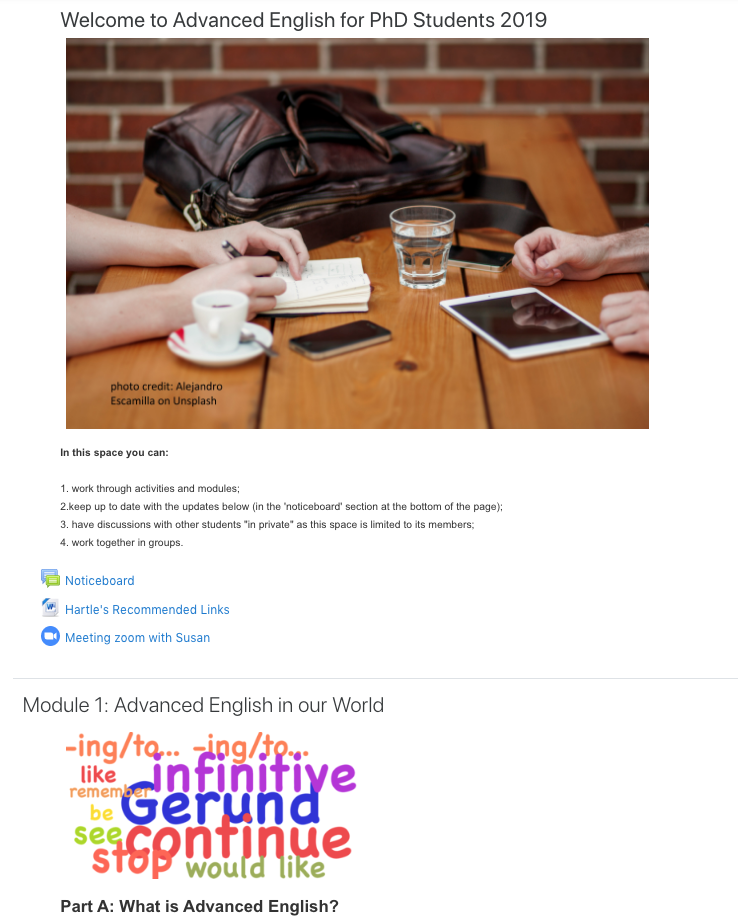
It is used as a platform which is used both in class and outside of class. Learners can access it for information about the course and to contact the teacher or each other and can also download and interact with materials both during lessons and independently. What is important, when organising such a space is that a) it does what you need it to do and b) that the structure is clear to all the users. In the image on the left, for instance, which comes at the top of the page (or the start of the course) learners are firstly told what they can do on the space and then provided key links to the noticeboard, links that are useful for them and the first meeting. The next block moves straight into the first module. Time needs to be spent in the first lessons going through the layout, where the messages are etc. until this is clear to everyone. Taking the time to do this means avoiding problems further down the line when learners cannot understand how to navigate the resources.
I opted to blend this resource with regular Zoom lessons which were held at the normal lesson times, in order to maintain a semblance of normality. I consider myself to be quite lucky, in fact, because I had already had quite a lot of experience with remote teaching so the transition was not painful for me, although the sheer number of hours spent behind a screen during the past two months has taken its toll, another aspect to consider going forward. I have decided, therefore, to provide a few reflections and ideas about how anyone, even those with very little experience of video conferencing can make the most of online teaching.
basic tips for remote teaching
Preparation for a video conferencing session
1.Use the synchronous video conferencing space as a «classroom»
2.Use a Learning Management System (LMS) such as Moodle for outside/in class materials access.
3.Use your desktop and share your screen to use other apps during the lesson to provide a change in pace and to use the resources available to do what you want to do. If you want your learners to write or brainstorm something and then comment on it, for instance, Padlet is an excellent choice for this. Kahoot, on the other hand is an excellent tool for reviewing content in a motivating gamified way.
4. Prepare documents and files you want to use in advance so that you do not waste time waiting for them to load whilst you are teaching. This can be stressful for you if you cannot find something or it takes your pc a minute to load a document. The learners may not notice particularly that it is taking time but it is stressful for the teacher.
5. Plan your lessons and have notes to help you as usual, you do not need to memorise every step of the lesson, but it is useful to visualise what you will be doing and what your learners will be doing at any stage of the lesson.
Ten tips for the remote lesson itself
- Provide some work to prepare in advance. As was mentioned above, hours spent in front of a screen lead to stress and burnout so the actual synchronous lessons may be shorter than usual with a ten minute phase at the beginning where learners are asked to read something or to do an exercise: a type of quiet time. This may also be done at the end of the lesson too.
- Create a warmer just as you would in a “physical class”. learners are coming from different contexts and need a few minutes to switch into lesson mode. The chat box can be a wonderful resource for this. During the COVID emergency, I once asked learners simply to share with us a moment of “joy” from their weekends, to raise the emotional level in the class. At that point many were frightened and frustrated with the lockdown. I started by saying that the quiet outside my window meant that I could listen to the birds singing as I had my morning cup of tea. Students wrote about baking with their family or going back to painting and one student showed us his artwork. A warmer may also simply be a quick review on the whiteboard (or if you do not have a whiteboard use a Word document) of vocabulary that came up in a previous lesson or other content. Polls or brainstorming can also be done and Mentimeter is an excellent tool for this. These are just one or two ideas but the possibilities are endless.
- In long lessons ask students to get up and move for five minutes. You can even integrate this into your lesson, asking them to find an object in their home which is memorable to them, for instance and then bringing it back and telling other students about it.
- Provide work to do outside class such as project work to do collaboratively by means of Whatsapp groups. IN my translation course different groups worked in different sections of a text during the week like this and then posted their translations on Padlet before the lesson, so that the work they had done could then be integrated back into the synchronous lesson.
- Pace the lesson. A change in pace can be introduced simply by using the chat box for learners to answer simple questions or by organising small group activities in breakout rooms. When doing this, however, it is important that everyone knows what the task is and what their role is. Activities can be demonstrated in the main room before learners split up. It is useful to check whether everyone has found the exercise they are to work on etc. You can simply ask them to type “yes” into the chat box if they have got the exercise. If they need to share their screens check that they know how to do this before they go into the breakout rooms, and monitor their activity in the usual way.
- Vary activities and activity types. A regular structure can be reassuring to learners who come to expect certain rituals such as a warmer at the beginning of the lesson, but it should not always be the same one.
- Record lessons to put on the Learning Management System (LMS) later if this is permissible in your context. In my context university students are adults and the recordings were only provided on their specific Moodle courses. They will also be removed at the end of the course. In this way privacy is respected but the recordings have proved to be very popular with students both when they miss a lesson and when they wish to return to a lesson to review content etc.
- Use your common sense Sometimes we look for complicated technological solutions to problems like how to embed an audio file into a particular online space when it would be just as simple to play the file on your telephone and let learners listen to it through your computer’s microphone.
- Take the stress out of the process by trying out the things you want to do in advance and take things slowly. If you have never taught online before you will be getting used to the technology so introduce new things slowly, one at a time until they just become an invisible part of your teaching practice.
- Pace yourself as well as your learners creating spaces in your lesson and your day where you can get up move around and leave the screen.
concluding
To conclude, I have to say, that despite the stress and exhaustion of this emergency period I feel a sensation of hope when it comes to remote teaching. Something that in the past was looked on often as an added extra has now moved into centre stage. I do not mean that I will not be happy to finally get back into the classroom. In fact I promised my learners that when that does happen we will meet “in the flesh” and have a party, but I feel that the affordances of technology have come into their own and perhaps will be integrated in a different way in the future.
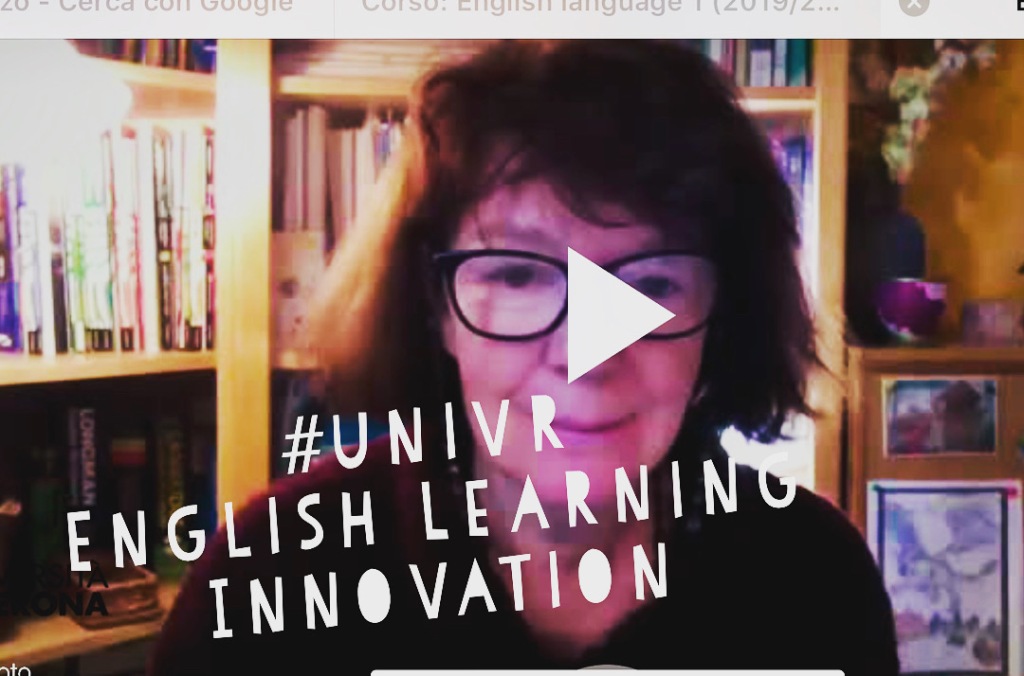




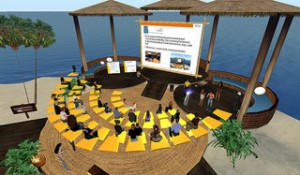
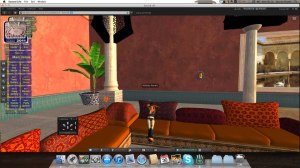




 Practice and more practice
Practice and more practice What sort of blend do you like?
What sort of blend do you like? Spring in the air
Spring in the air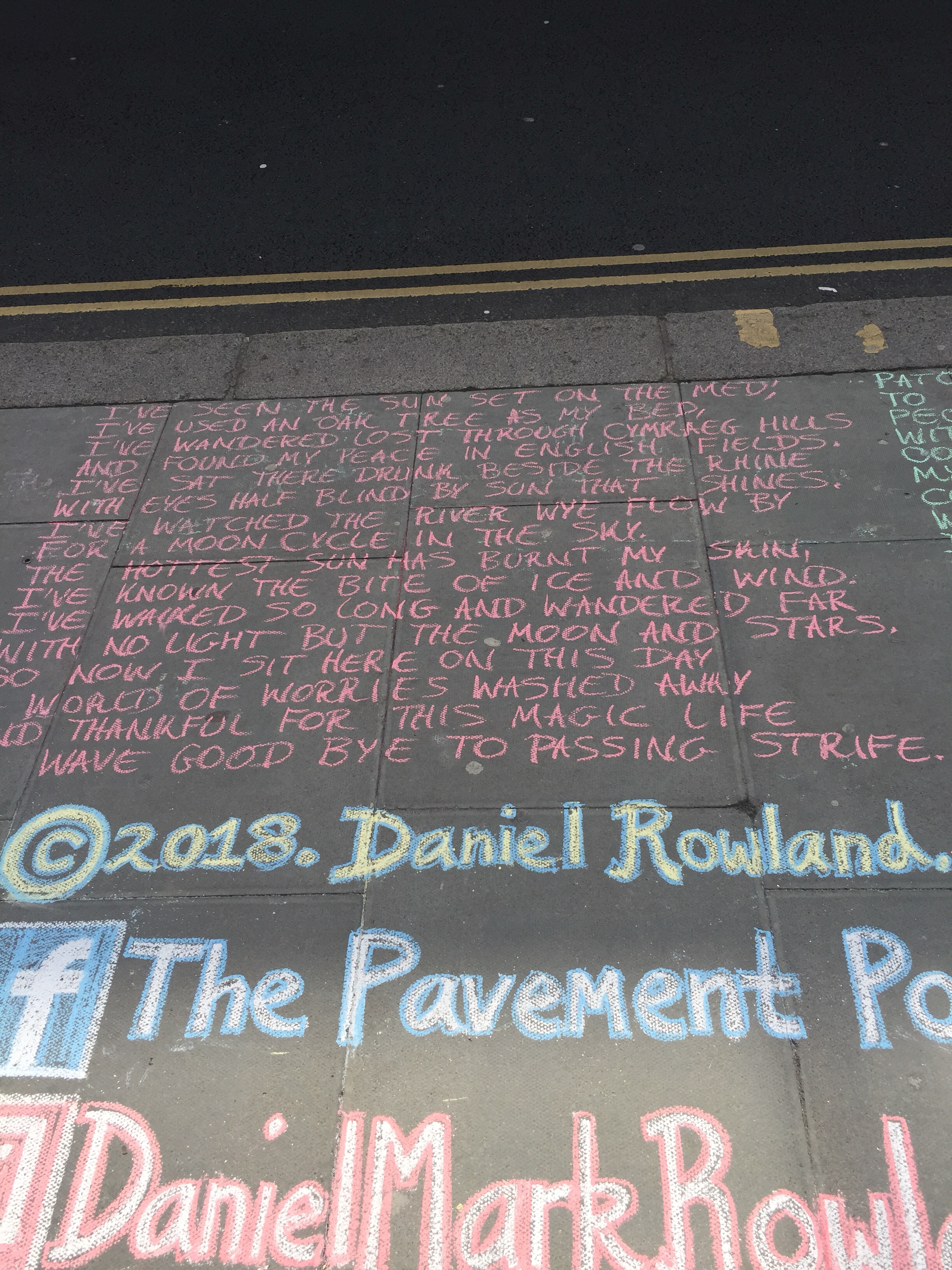





 Keep on Developing
Keep on Developing